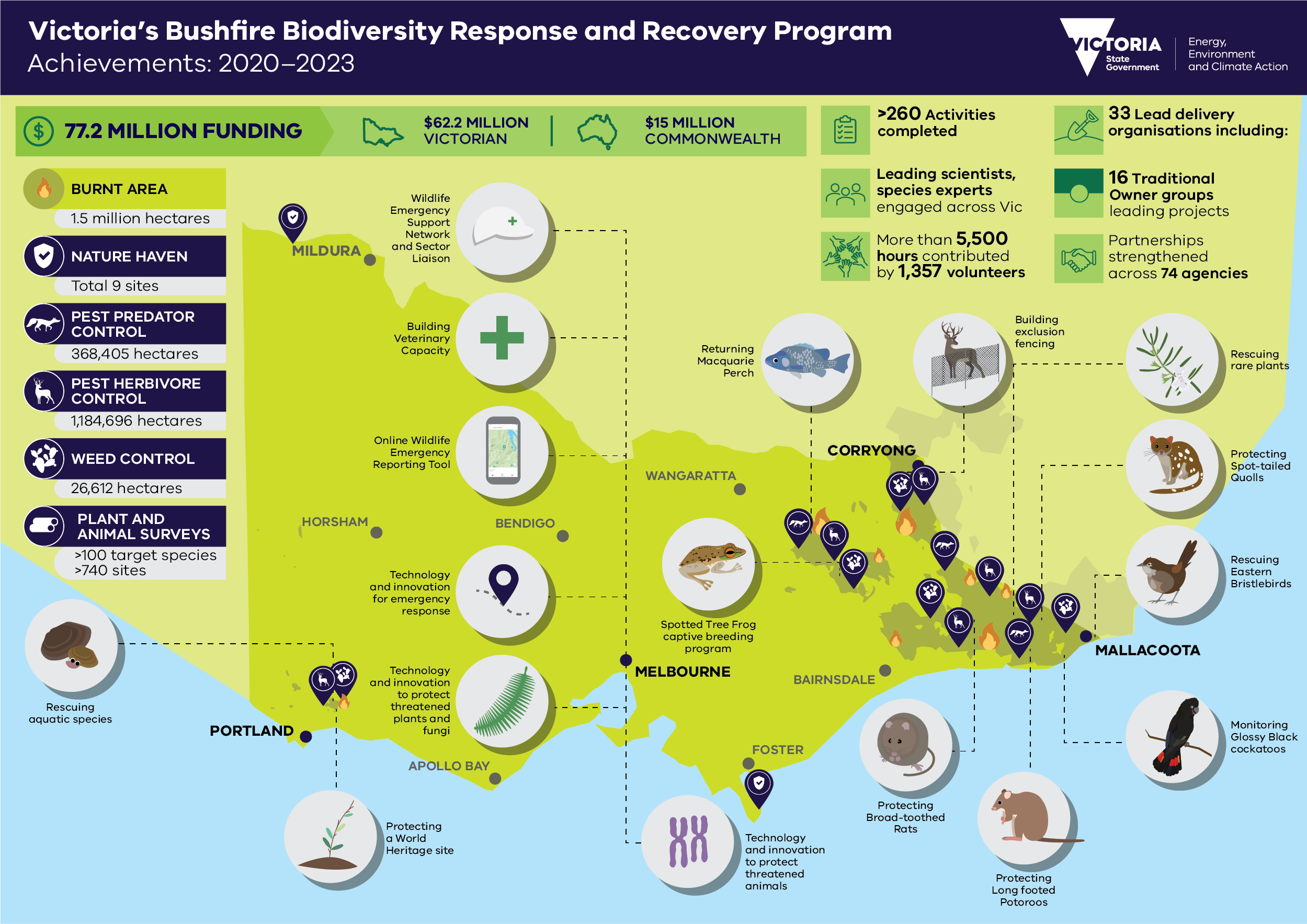
Bushfire Biodiversity Response and Recovery program
The Victorian Government provided $54.5 million for the Bushfire Biodiversity Response and Recovery (BBRR) program to support Victoria’s bushfire impacted wildlife and biodiversity.
This was supported by $15 million from the Australian Government bushfire recovery package for wildlife and their habitat.
The Victorian Government also contributed $7.7 million to re-seed Alpine and Mountain Ash Forests as part of the broader bushfire recovery program.
Guided by initial and subsequent reports, DEECA worked alongside species experts, academics and land managers to prioritise actions for fire-affected threatened species and habitats.
This formed an overarching, multi-year program of initiatives across four phases:
- Emergency response actions (while the fire was active)
- Phase 1: Immediate and short-term actions (up to 1 year)
- Phase 2: Medium-term action (1-3 years)
- Phase 3: Longer-term actions (beyond 3 years)
DEECA worked closely with partner agencies, Traditional Owners and non-government organisations to coordinate and support actions to help the protection and recovery of Victoria’s flora, fauna and habitats impacted by the 2019-20 fires.
The BBRR program delivered actions across a range of themes and focus areas from 2020 to 2023.
Themes
Funding allocation: $2.1M (approx.)
Assessing the specific impacts of the fires on species or locations of concern enabled more targeted actions.
This theme assessed the status of key plants, animals and ecosystems following the fires to inform management actions.
The focus was on species or ecosystems that have had all known populations/locations affected or where the level of impact is not fully known.
Key actions:
- Ground surveys and aerial surveys (where appropriate)
- Surveys following standard scientific methods to ensure comparisons with pre-fire surveys
- Provision of artificial habitat features
- Further risk assessment
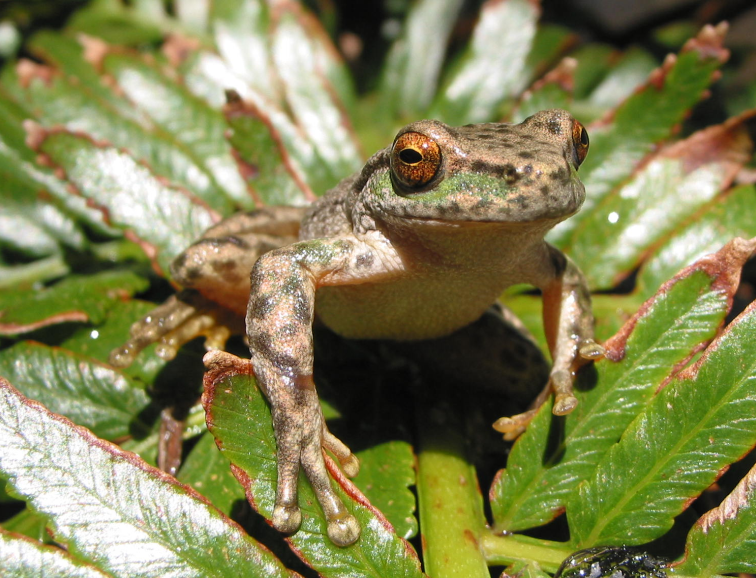
Image: Spotted tree frog (Glen Johnson)
Funding allocation: $1.5M (approx.)
The effects of the fires can impact the ability of some threatened species to persist in their natural environment.
This theme prioritised options for the emergency extraction of these species at risk of extinction or further decline.
The aim was to collect critically threatened fauna species and keep them in temporary care or at an alternative wild location, as well as collecting threatened flora seeds and cuttings for propagation, until the species can be returned to the wild.
Key actions:
- Emergency extraction and temporary housing or translocation of critical fauna (e.g. fish and aquatic invertebrates, eastern bristlebird)
- Collection of seed/plant material and ex-situ propagation for key plant species.
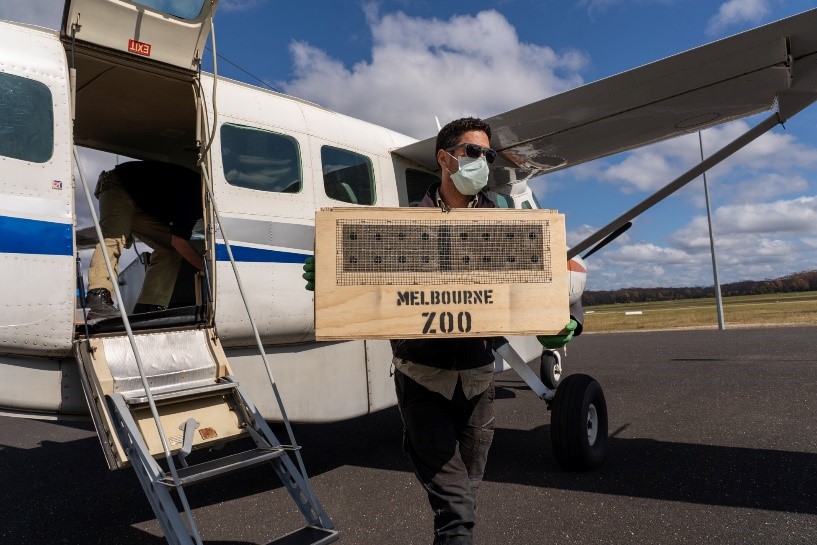
Image: Bristlebird extraction (Darryl Whitaker)
Funding allocation: $1.0M (approx.)
Responding to the welfare of wildlife injured during fire is a critical element of the Victorian Government’s fire response procedures.
There is also significant community concern for wildlife during fire events.
This theme built on existing arrangements and sought to closer engage with communities on wildlife response during fires.
This included identifying improved coordination and communication with wildlife carers and advocacy groups.
Key actions:
- Working with key wildlife welfare organisations around improved engagement
- Development of targeted training programs for veterinarians on wildlife assessment, burns treatment and triage
- Undertaking a post-rehabilitation study to track released koalas that were taken into care following the fires
- Development of an electronic recording system for the collection of wildlife assessment and triage data
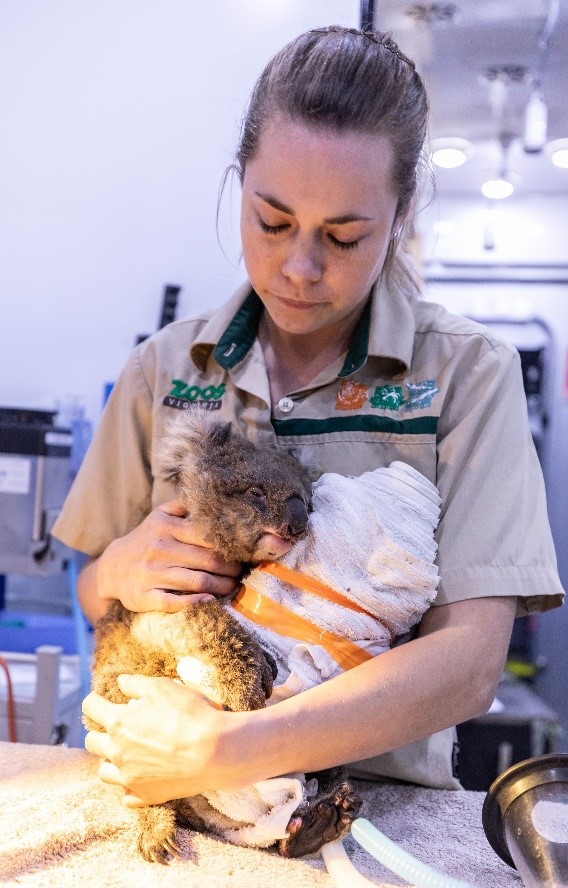
Image: Koala assessment (Marcia Riederer)
Funding allocation: $25.0M (approx.)
Wildlife and habitats affected by fires are more vulnerable to introduced pest plants and animals.
Some pests can thrive in a post-fire landscape, increasing their impact on an environment that is already compromised.
This theme delivered an integrated and coordinated program focused on introduced herbivore and predator control, and weed control, to reduce the heightened risks in burnt and adjacent areas.
Key actions:
- Aerial shooting of introduced pest animals on public land
- Targeted ground control of introduced pest animals
- Targeted weed control
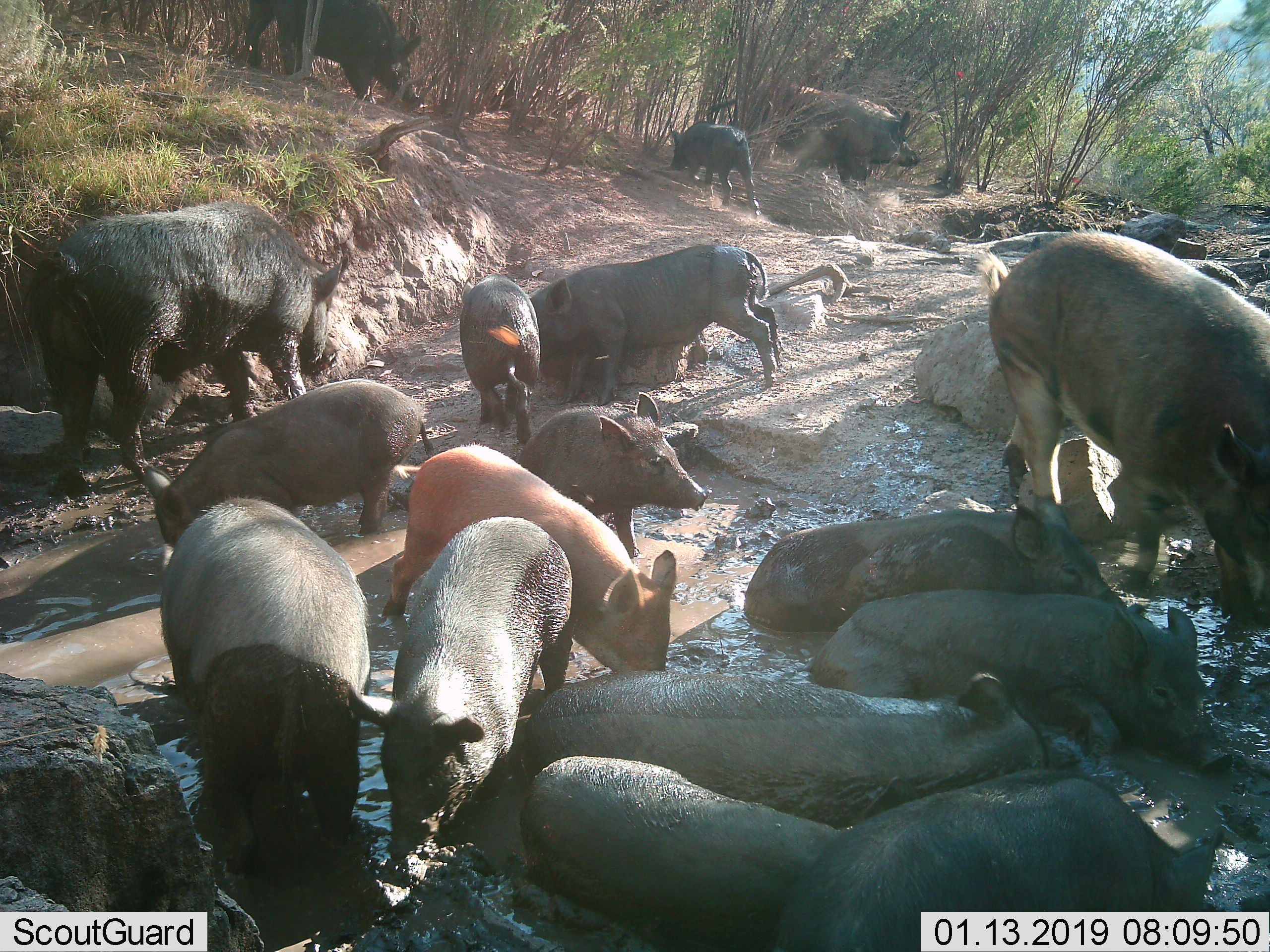
Image: Feral pigs wallowing (ScoutGuard)
Funding allocation: $2.1M (approx.)
This theme aimed to heal Country through reading Country.
It enabled Traditional Owners to apply ecological knowledge and lead the coordination of cultural heritage and related activities in the fire-affected areas.
Funding allocation: $19.5M (approx.)
The recovery of species affected by the fires will benefit from actions both within and beyond the 2019-20 fire area.
This theme focused on maximising the long-term statewide resilience of species and their habitats across the landscape, with emphasis on species of greatest concern after the fires.
Key actions:
- Create and support a nature haven network of ecological refuges across the state
- Revegetation and reseeding
- Spread the risk to a species from future disturbance events by establishing a new population
- Spread the risk to a species from population failures through genetic mixing to improve the fitness of populations and manage threats
- Applying a cultural landscape lens to species renewal and resilience using cultural knowledge and practices
Funding allocation: $1.8M (approx.)
This theme aimed to improve our knowledge of expected biodiversity outcomes from post-fire management of threats and improve preparedness for protecting biodiversity during future fire events.
This included identifying priority options across Victorian landscapes to reduce the risks to biodiversity in the event of future fires.
Key actions:
- Developing strategic guidance to prioritise direct interventions in species populations (e.g. to address genetic risk)
, - Better targeting of research and monitoring of management effectiveness
- Continuous improvement of biodiversity information and decision-support tools
- Developing systems to improve data flow across agencies and to the public
Funding allocation: $0.1M (approx.)
Connecting with nature has benefits for people and for biodiversity.
The aim of this theme was to enable social, economic, and environmental recovery of fire-impacted communities, led by nature.
It supported Victorians' recovery from the fires by facilitating their engagement in activities to assist the recovery of nature.
Fire-impacted communities were supported to learn about how nature is responding, and to design and deliver projects that benefit local plants, wildlife and habitats.
Participating in these projects, witnessing natural recovery, and gaining a sense of hope and agency, can actively support recovery of fire affected communities.
Key Actions:
- Providing grants to support community-led, place-based, small projects
- Providing access to scientist/expertise to assist understanding and opportunity
- Supporting meaningful citizen science and volunteering projects
- Encouraging people to notice nature recovery
- Sharing stories of recovery
Funding allocation: $1.5M (approx.)
This covers coordination and support across partners, as well as communications, engagement and program administration across all themes.
Achievements
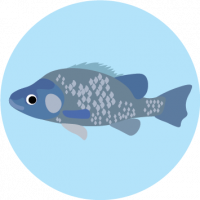 | Returning Macquarie perch Macquarie perch translocated to improve genetic diversity in areas where fire had severe effects on remaining populations. Woody weed control underway in key habitat areas will further help the recovery of this species. |
 | Spotted Tree Frog captive breeding program Post fire surveys indicated that key populations were reduced. Captive breeding program established at Zoos Victoria to help bolster wild populations and prevent extinction. |
 | Protecting broad-toothed rats Ongoing landscape-scale actions including introduced herbivore and predator control implemented across species distribution. Investigations into technology and scientific innovation to help bring this species back from the brink. |
 | Monitoring glossy black-cockatoos Mapping and protection of surviving black she-oak trees, their only food source, to help them recover. Citizen science project to record sightings through Birdlife Australia’s Great Glossy Count |
 | Rescuing eastern bristlebirds Small insurance population evacuated as fire approached the last remaining population in Victoria. Housed by Zoos Victoria and returned in 2020. Artificial Intelligence developed to identify eastern bristlebird calls to help track populations. Translocation of birds to secure a second population in Victoria. |
 | Protecting long-footed potoroos The Southern Ark and Barry Mountains fox control programs have expanded to deliver an additional 207,000 hectares of control, providing greater protection to long-footed potoroo populations from the threat of fox predation. New sightings outside their known range are a sign of hope for their recovery. |
 | Protecting spot-tailed quolls Ongoing landscape-scale actions to support recovery, including control of introduced herbivores and predators across their range. Investigations into species translocation and scientific innovation to bolster Victorian populations. |
 | Rescuing aquatic species 11 threatened aquatic species evacuated from fire affected areas where ash and sedimentation were an ongoing threat to water quality. More than 600 individual animals safely housed in aquaria at the Arthur Rylah Institute for environmental research and returned later in 2020. Rescuing threatened aquatic species after the East Gippsland bushfires |
 | Rescuing rare plants 108 threatened plants species located and 105 collected and stored in the Victorian Conservation Seed Bank or living collection as insurance in the event of future environmental disaster. Seed collection to safeguard threatened plants The large-scale operation cultivating rare plants - Gardening Australia |
 | Technology and innovation to protect threatened plants and fungi New technology acquired at Royal Botanic Gardens Victoria to:
|
 | Surveying plant and animal populations Specialist Rapid Risk Assessment teams deployed immediately post fire to inform emergency recovery actions. Since 2020, more than 160 species of concern assessed in the field across more than 740 sites, to help inform medium- and long-term recovery actions. |
 | Building exclusion fencing 31 hectares of exclusion fencing constructed, enabling the successful recovery of threatened and important species such as the Shelley leek orchid - found nowhere else in the world. |
 | Controlling introduced herbivores Large-scale control program targeting deer, feral pigs and feral goats to protect threatened plants and animals at-risk from the impacts of grazing, trampling and wallowing. Sustained control is expected to benefit more than 690 native plant and animal species including the threatened brush-tailed rock wallaby, alpine she-oak skink, eastern bristlebird, Betka bottlebrush and Snowy River westringia. Coordinated and integrated management over 565,000 hectares to reduce introduced herbivore numbers in areas of high biodiversity value. Key management actions include:
|
 | Controlling introduced predators Landscape-scale fox control to reduce the impact of predation and competition on threatened species recovering from fire. Management of more than 207,000 hectares of high priority habitats with a particular focus on the protection of critical weight range mammals such as the long-footed potoroo, long-nosed potoroo, spot-tailed quoll, southern-brown bandicoot, long-nosed bandicoot and brush-tailed rock wallaby. Key predator control activities include:
|
 | Controlling weeds The risk of weed invasion increases dramatically after fires, leading to new or more severe infestations that reduce the ability for native plants and animals to recover. Management of more than 17,000 hectares in high priority habitats to protect threatened plants and important plant communities such as Alpine Bogs and Coastal Rainforest Areas. Key projects include:
|
 | Protecting a World Heritage site An integrated invasive species control program is being delivered across the Budj Bim World Heritage Landscape to protect important environmental and cultural values such as Manna gum trees and the extensive 6,600 year old aquaculture system. Strong partnerships with Traditional Owners and stakeholder engagement are integral to ensuring the program’s success. |
 | Healing Country Empowering 10 Traditional Owner groups in fire affected areas to heal Country through self-determination. Spirit and threat management officer roles funded across the state. “We’re out taking the lead, getting to know the Country” - provided quote |
 | People power Participation of approximately 1,357 volunteers who provided over 5,500 hours to delivery of the program. |
 | Wildlife Emergency Support Network and Sector Liaison Appointed the Wildlife Welfare Sector Liaisons and established the Wildlife Emergency Support Network. |
 | Together for wildlife Wildlife Welfare Communications Group: DEECA, Zoos Victoria, Wildlife Victoria, Australian Veterinary Association (AVA), International Fund for Animal Welfare (IFAW), University of Melbourne, RSPCA Victoria and the Conservation Regulator are “Together for Wildlife” producing and sharing joint communications messaging about wildlife welfare. |
 | Technology and innovation for emergency response Fire impacts modelled for 4,200 species to help determine where to focus our recovery actions. Biodiversity risk dataset developed to help inform emergency management. |
 | Technology and innovation to protect threatened animals Expert scientists at Museums Victoria are investigating the capacity for frozen storage of reproductive material from threatened species in Victoria. The Smithsonian’s Cryo-initiative is an international example of this technology in practice. |
 | Building Veterinary Capacity Training program for veterinary staff in wildlife triage units, regional veterinary outreach program. |
 | Online Wildlife Emergency Reporting Tool Allows members of the public to report injured wildlife to DEECA during fire events. Recording system for DEECA response teams. |
 | Nature led community recovery Community events held for fire affected communities across the state, featuring presentations and tours by expert bushfire and biodiversity scientists. |
Reports
The report, Victoria’s bushfire emergency: Biodiversity response and recovery (PDF, 5.7 MB), assessed the fire extent as of 20 April 2020.
The 2019-20 Victorian bushfires burnt approximately 1.5 million hectares across Victoria. The bushfires impacted threatened species and their unique habitats, including approximately 78% of the remaining Warm Temperate Rainforest in Victoria.
The report assessed the impact of the Victorian bushfires on over 4,400 species. It found that 244 species of plants and animals had at least 50% of their likely statewide habitat burnt, 215 of which were rare or threatened species.
The Biodiversity Response and Recovery Supplementary Report: An assessment to prioritise medium term conservation actions and identify knowledge gaps (PDF, 7.8 MB) is a compilation of all the specific needs assessments and knowledge gaps identified by taxon experts following the 2019-20 Victorian bushfires.
It provides an assessment of the most potentially beneficial management actions for each species under a few key taxon.
Expert elicitation informed the results of causal models as per the Biodiversity Knowledge Framework.
Results demonstrate:
- Priority medium term conservation actions for 74 species (or species groups) over 11 taxon
- The estimated benefit to species persistence of selected actions in specific locations compared to no targeted management
- A ranked list of the most beneficial actions for each species (or species group) at a specific location to maximise likelihood of persistence
- Key knowledge gaps identified through causal models, highlighting key threats and uncertainties which should be prioritised for research to improve management outcomes (these will soon be accessible on the Knowledge Portal)
This provides a transparent and robust way to compare and prioritise potential management actions across locations and species, and integrate other factors such as cost effectiveness when planning a project.
Results gives an idea of what return you can expect from investment and targeted effort on a particular species, and completely comparable across taxa.
The Victorian Post-fire Reconnaissance Program assessed the impacts of fires on the species and ecological communities most at risk. It collected information to guide management actions to prevent further declines and maximise recovery opportunities for threatened species.
The Biodiversity Bushfire Response: Supplementary report on bushfire impacts on species in Victoria (PDF, 17.1 MB) highlights the impacts of the fires on our native species.
Developed in partnership with key partners and stakeholders, the report found that despite the devastating impacts of the fires, some species are showing strong signs of recovery, including the long-footed potoroo.
This program was instrumental in informing immediate bushfire recovery actions. This included threatened fish extraction and captive housing, deer management at threatened frog sites, and actions to support threatened species such as glossy black-cockatoo.
This evaluation assessed the design, delivery and impact of the Bushfire Biodiversity Response and Recovery program activities delivered under the three initial funding packages that concluded on 30 June 2021:
- Wildlife and biodiversity package (Victorian Government) – $17.5 million
- Manage immediate threats of pests and predators for species survival (Victorian Government) – $5 million
- Bushfire recovery package for wildlife and their habitat (Australian Government) – $3 million.
The evaluation report draws on both quantitative and qualitative data to demonstrate the impacts of these three packages of work and inform future programs.
The findings and conclusions are outlined below.
| Recommendation | Response |
|---|---|
| The long-term goals or outcomes of the program were sound and should be used as the starting point for similar future programs. | Accepted |
| The themes should be retained as the framework for future similar event responses. | Accepted |
| Retain the role of theme leads (or co-leads) managing planning and regional coordinators managing delivery of on-ground actions of the program. | Accepted |
| Continue the outcome focus of the program – with explicit adaptive management provisions – Allowing adjustments to approach while still delivering outcomes. | Accepted |
| Provide greater consideration to practical limitations of the circumstances of the fire and the pressures on the staff involved when setting program delivery timeframes rather than being driven by financial year deadlines. | Accepted |
| Recognise that programs of this scale and complexity will have natural phases – e.g., a ‘ramp-up’ phase, operation phase and maintenance (or BAU) phase. These phases can also be significantly influenced by seasons (i.e., some actions can only be delivered at certain times of year). These administrative and natural factors should be built into delivery planning to ensure resources and demands on staff are well managed. | Already implemented - Nested timeframes for planning and delivery phases were reflected in program planning, design and delivery from the outset. (Link report) |
| Continue to foster collaborations during program delivery and highlight any volunteer contributions or co-investments from partners and stakeholders. | Accepted |
| Transition invasive species control into long-term maintenance program to ensure the significant progress is preserved. | Accepted in principle – Funding dependent |
Continue monitoring the impact of the on-ground actions to identify whether the 'Beyond program' biodiversity outcomes do occur, particularly:
|
Accepted in principle - Funding dependent - To be addressed in coordination with VAGO Biodiversity 2037 and parliamentary inquiry responses. |
| Continue support and maintenance of insurance populations of threatened flora species held by the Royal Botanic Gardens (including the propagation program) | Accepted in principle – Funding dependent |
| Continue to support partnerships created through this program by incorporating on-going contact between collaborators into existing forums or professional gatherings (e.g., DELWP Biodiversity Managers could be altered to include other organisations) | Accepted |
| Identify possible landscape-scale fire events that would have major biodiversity impacts as part of state-wide strategic bushfire management planning (and associated modelling). Use this information to identify areas where contingency plans for such events should be prepared. | Accepted – to be addressed through ecological refuge modelling. |
| Identify other species at risk of extinction from single events (bushfires, floods, storm events, heatwaves) and prepare plans for the actions that may be required (e.g., emergency extraction) should those occur. | Accepted – underway through maximising resilience projects. |

Page last updated: 15/11/24